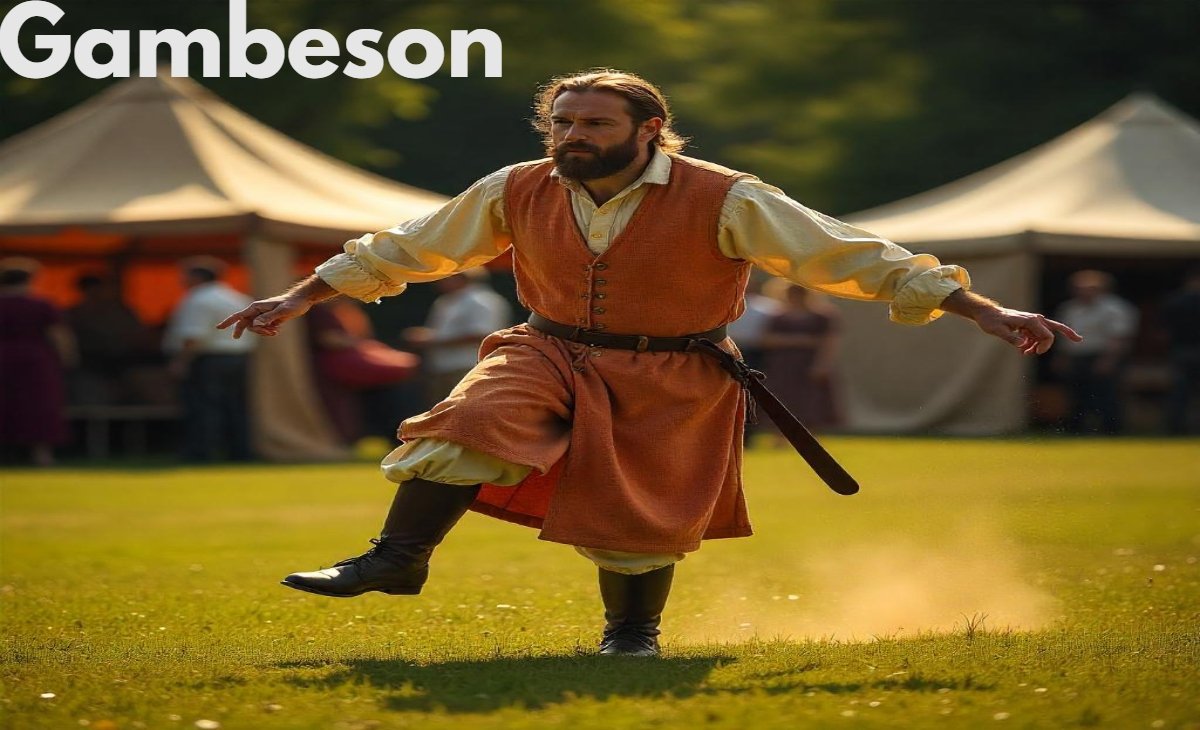Introduction: Defining the Essential Defense by Gambeson
Before gleaming plate dominated battlefields, before intricate maille became widespread, a simpler, yet profoundly effective form of protection reigned supreme: the gambeson. Often relegated to the background in popular depictions of medieval warfare, this quintessential padded garment was the indispensable foundation of personal defense for centuries. Far more than just under-armor, the gambeson was frequently the primary protection for vast numbers of warriors across diverse cultures and social strata. Its significance lies not in ostentation, but in its practical genius – offering crucial resilience against crushing blows, piercing points, and the harsh realities of combat, all while remaining relatively affordable and remarkably versatile. Understanding the gambeson is fundamental to understanding the true nature of pre-modern warfare.
Early Origins and Development of Gambeson
The core concept of padded protection stretches far back into antiquity. Early civilizations experimented with layered fabrics, leather, and other fibrous materials to absorb the energy of impacts. Evidence suggests rudimentary forms existed in ancient Greece and Rome, possibly worn under metal armor or by less heavily equipped troops. However, it was during the early medieval period in Europe, roughly from the 9th to the 11th centuries, that the garment we recognize as the gambeson truly began to crystallize. As centralized military structures waned following the Roman Empire’s fall, warfare became more localized, often involving levied infantry and smaller retinues.
The expense and complexity of extensive maille meant many fighters relied on more accessible defenses. The evolution of the gambeson filled this critical gap, providing essential protection that was achievable with widely available materials and textile skills. Its development paralleled the rise of feudal systems and the increasing importance of infantry alongside cavalry.
Materials and Construction of Gambeson
The true strength of the gambeson resided in its meticulous construction, not exotic materials. Typically crafted from readily available linen or wool, the outer shell provided durability. The magic happened inside. The core was densely packed with resilient fibers – chopped wool (flock), tow (coarse flax fibers), cotton waste (in later periods and specific regions), or even raw cotton. Horsehair was also occasionally documented, prized for its springiness. The key was the quantity and compaction of this stuffing.
The most critical element was the quilting. Thousands of stitches held the layers firmly together, creating a dense, impact-resistant matrix. Quilting patterns weren’t merely decorative; they served vital structural functions. Close, parallel rows running vertically, horizontally, or diagonally prevented the stuffing from shifting and compacting unevenly during a blow. More complex diamond or lozenge patterns offered enhanced rigidity and distributed force more effectively across a wider area. The stitching depth and thread tension were paramount, requiring significant skill to achieve uniform density throughout the garment. Stitch length and pattern directly influenced the defensive qualities, transforming flexible cloth into a remarkably resilient barrier. Thickness varied greatly, from thinner versions worn beneath maille to standalone defenses several centimeters thick, capable of stopping arrows at certain ranges.
Forms and Variations in Gambeson
The gambeson was not a single, monolithic garment. Its form evolved significantly over time and varied depending on its intended use, the wearer’s status, and regional preferences. Early versions were often relatively simple, knee-length tunics (sometimes called aketons), split at the front and back for riding, with integral sleeves. These provided comprehensive torso and upper leg coverage.
As armor technology progressed, particularly with the increasing use of maille hauberks, the gambeson adapted. It became common to wear a thinner, tightly fitted version specifically designed to be worn under the metal mesh. This “arming garment” served multiple purposes: cushioning the wearer from the weight and chafing of the maille, preventing the metal rings from pinching skin or underclothes, and adding an extra layer of absorption against impacts transmitted through the links.
Alongside these under-armor versions, the standalone gambeson remained vital. These were typically thicker and often featured more robust construction. They might include features like reinforced shoulders, higher collars (stand-up or later, the “standard” collar), and sometimes integrated defenses for the upper arms (spaudlers) or even rudimentary breastplates made from layered fabric or horn (a jack). The iconic “jack” prevalent in the 14th and 15th centuries, particularly among English archers and infantry, was essentially a specific, often shorter and sleeveless, form of thick standalone padded defense, sometimes incorporating small metal plates or horn between layers.
Functionality on the Battlefield of Gambeson
The gambeson’s battlefield effectiveness was multifaceted and often underestimated:
Blunt Force Trauma Absorption: This was arguably its primary function. Against the crushing impact of maces, war hammers, clubs, and even the concussive force transmitted through swords or axes striking maille, the dense, quilted layers dissipated energy remarkably well. It acted like a shock absorber, significantly reducing the risk of broken bones and debilitating internal injuries. A warrior wearing only maille over regular clothing was far more vulnerable to such trauma.
Piercing and Cutting Resistance: While not impenetrable to determined thrusts from spears, lances, or arrows, especially at close range, a well-made gambeson provided substantial resistance. The tightly packed fibers could bind around a weapon point, slowing penetration significantly. It was highly effective against glancing blows, slashes, and even arrows shot from longer distances. Chronicles and combat treatises frequently attest to its ability to stop arrows that would have otherwise been lethal. Against cuts, the layered textile could snag blades, reducing their effectiveness.
Essential Support for Maille: When worn beneath a hauberk, the padded layer prevented the metal rings from being driven directly into the body upon impact, enhancing the maille’s own protective qualities. It also made wearing the heavy metal mesh more comfortable and less damaging to the underlying clothing and skin over long periods.
Thermal and Abrasion Protection: The thick layers offered insulation against cold weather. It also protected the wearer’s skin and finer clothing from abrasion caused by the constant movement of metal armor (maille or plate) or rough equipment.
The Wearers: From Knights to Common Soldiers
The gambeson’s accessibility defined its ubiquity. While knights and men-at-arms relied on it as essential under-armor for their expensive maille and later plate harnesses, its true importance lay in its service to the vast majority of medieval fighters who could not afford full metal suits. Foot soldiers, including spearmen, billmen, and crucially, the legendary English and Welsh longbowmen, depended heavily on thick standalone versions, especially the jack, as their primary torso defense. Men-at-arms might wear a thinner one under plate, while their squires or less wealthy companions might wear a thicker one alone or with minimal additional metal defenses like a breastplate or brigandine. It was the armor of the levy, the town militia, the garrison soldier, and the professional infantryman. Its affordability, derived from using textile and common stuffing materials rather than costly metal and specialized metalworking skills, democratized battlefield protection to an unprecedented degree for the era.
Cultural Significance and Legacy Beyond Warfare
The influence of this padded defense extended beyond the battlefield. Its construction principles were employed in other protective garments. The arming doublet, worn under plate armor in the late medieval period, evolved directly from the under-armor gambeson, incorporating points to tie on plate pieces. The concept of layered, quilted protection found use in civilian contexts, such as in some forms of winter clothing or garments worn for hazardous work. The term itself became somewhat synonymous with sturdy, quilted jackets in various contexts.
Furthermore, the gambeson holds significance in the study of material culture and social history. Its construction reflects the textile technologies, resource availability, and tailoring skills of the period. Variations in design hint at regional differences and evolving military needs. Its near-universal use underscores the practical realities of warfare for the majority of participants, contrasting sharply with the romanticized image of the fully armored knight. It represents the ingenuity of using available materials to solve the fundamental problem of survival in combat.
The Gambeson in the Age of Plate and Decline
The rise of full plate armor in the 14th and 15th centuries transformed battlefield protection, but it did not immediately render the gambeson obsolete. Instead, its role adapted. As plate coverage became more comprehensive, the thick standalone padded defense became less necessary for the fully armored knight on the front lines. However, the arming garment worn beneath plate remained absolutely crucial. This evolved garment, often referred to more specifically as an arming doublet or pourpoint, was typically thinner and more precisely fitted than earlier versions. Its primary functions shifted slightly but remained vital: providing a comfortable, padded base; securing the plate armor via points (laces); and offering residual protection for areas not fully covered by plate (armpits, inner elbows, back of knees) and against the concussive force transmitted through the plates themselves.
For troops not outfitted in full plate – which remained the majority – the standalone gambeson, particularly the jack, continued to be the mainstay defense well into the 16th century, especially for archers and pikemen. Its effectiveness against arrows and the concussive force of early gunpowder weapons (to a limited extent) ensured its longevity. However, the increasing power and prevalence of firearms, particularly the arquebus and musket, ultimately diminished the effectiveness of textile-based armors.
While buff coats (made of thick leather) and later, layered cloth coats, persisted for cavalry and some infantry into the 17th century and beyond, offering some protection against swords and pistols, they represented an evolution beyond the classic medieval padded defense. The development of more effective and affordable metallic armors like the brigandine also offered alternatives. By the late 16th and early 17th centuries, the gambeson in its traditional form faded from widespread military use, replaced by newer technologies or abandoned in the face of gunpowder dominance.
Modern Rediscovery and Reinterpretation
After centuries of obscurity, interest in the gambeson has surged, fueled by historical reenactment, live-action role-playing (LARP), and historical European martial arts (HEMA). Practitioners require functional armor that accurately reflects historical examples for safe sparring and combat simulation. Modern makers meticulously research historical sources – manuscript illustrations, effigies, rare surviving fragments, and textual descriptions – to recreate authentic designs using traditional materials and techniques where possible. This practical reconstruction has provided invaluable insights into the garment’s true construction, weight, flexibility, and defensive capabilities, often confirming historical accounts of its effectiveness that were previously met with skepticism.
Beyond reenactment, the gambeson’s aesthetic – the distinctive quilting patterns, the robust yet flexible form – inspires modern fashion and design. Elements appear in avant-garde clothing, costume design for film and television (where its practicality and historical accuracy are increasingly valued), and even in protective gear for motorcycling or other sports, demonstrating the enduring legacy of its functional design. Modern materials like high-density foams and synthetic fibers are sometimes incorporated into reinterpretations, blending historical form with contemporary technology for specific applications, though purists often favor traditional approaches for authenticity.
Conclusion: The Enduring Importance of the Quilted Defense
The gambeson stands as a testament to medieval ingenuity and the practical realities of warfare. It was not merely a stopgap for the poor, but a sophisticated piece of military technology in its own right, essential for warriors of all ranks for hundreds of years. Its layered, quilted construction provided vital protection against the brutal forces of medieval combat, democratizing defense in an era dominated by metal armor’s expense. It served as the indispensable foundation upon which more elaborate armors were built and remained the primary defense for countless soldiers. While eclipsed by technological advances, its principles of impact absorption and layered resilience remain valid. The modern revival of interest, driven by hands-on reconstruction and historical study, has finally brought this unsung hero of medieval warfare the recognition it deserves, solidifying its place as a cornerstone of historical defensive equipment. The gambeson truly was the quilted heart of medieval armor.





